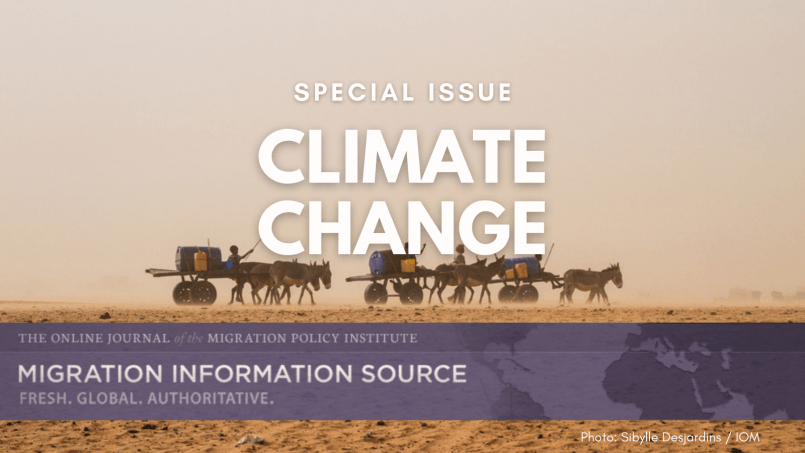Special Issue: Climate Change and Migration
Special Issue: Climate Change and Migration
The Migration Information Source is devoting a special series of articles to addressing how a changing climate is affecting international and internal migration now and what its effects might be in the future. The impact of climate change on human movement across the globe is likely to be profound—though perhaps in significantly different ways than are perceived today. This special issue, with articles from leading scholars, examines the connection between climate change and migration through historical, scientific, and legal overviews, on a global scale and in individual countries. The special issue is accompanied by a podcast, Changing Climate, Changing Migration, hosted by Migration Information Source Editor Julian Hattem, which you can find on this website or wherever you listen to your podcasts.
Floods, heatwaves, and other extreme weather events have displaced hundreds of thousands of people in Iran, with repercussions for residents including the 3.4 million refugees and other forced migrants, who are restricted to climate-affected areas. Environmental challenges may also be pushing some people to move internationally. This article offers a rare look at the climate and migration dynamics in Iran.
Is climate change a major driver of migration and displacement? From where are people leaving, and where are they going? This informative primer, a Climate Migration 101 of sorts, provides answers to basic questions about climate change and migration, starting with how and where climate change triggers human movement.
Despite the widespread impression that people inevitably migrate away from climate-vulnerable areas, many adapt to environmental changes, choose to remain in their homeland, or simply cannot leave, due to a lack of money, connections, legal avenues, or other means to do so. These “trapped populations” may be among the most affected victims of climate change, this article explains.
Researchers often seek to predict how many people will move due to climate change, but beyond the inherent forecasting difficulties, their work is complicated by the fact that terms such as "climate migrant" are nebulous and migration drivers are often multifaceted. Instead, this article explains why analysts might ask how climate change will reshape existing patterns of migration and immobility.
Can haphazard, unplanned climate displacement be turned into voluntary, safe migration? Projects explicitly aimed at addressing internal and international climate migration are rare, but development organizations increasingly are turning their attention to supporting them. This article catalogues climate mobility projects around the world and examines their primary goals, whether to support the movement or stay of people or help at destination.
The discovery of massive oil reserves off the Guyana coast will bring immense riches to this small South American country. This windfall will draw migrant labor and the return of some diaspora members to Guyana, which has one of the world's highest emigration rates. It also could accelerate climate displacement in a country where 90 percent of the population lives in coastal areas below the sea level. This article explores the changes ahead.
Climate change is compounding the drivers of displacement and international migration in Afghanistan, which has one of world's largest populations of internally displaced persons (IDPs). This article examines the climate and environmental linkages to displacement and migration, as well as the policy approaches taken by the Taliban and predecessor governments, particularly as they relate to water resources management.
Climate change has had a devastating impact on many poor Central American farmers, which can contribute to food insecurity and may be prompting migration from the region's Dry Corridor. But the process is not straightforward. As this article explains, most poor farmers rely on a combination of buying, cultivating, and foraging for their food, which makes it difficult to predict how people will react to individual climate events.
Migration can help build resilience against the encroaching effects of climate change. Instead of being passive victims of environmental degradation, individuals sometimes move to gain money, knowledge, and skills that can fortify their household of origin. Migrant workers from Thailand demonstrate how and under what conditions this process works.
Climate-induced migration can lead to tensions and violence between host communities and new arrivals. This conflict can flare up at various levels, including among rural farmers and herders in relatively peaceful countries such as Tanzania.
Climate change is affecting human movement now, causing internal displacement and international migration, and will do so in the future. But the impact is often indirect, and rarely is the process as straightforward as one might think. This article provides an overview of research on how climatic hazards drive and affect migration, reviewing which types of people might migrate and under what conditions.
Coastal communities in India are confronting the effects of sea-level rise, erosion, flooding, and cyclones. This article examines displacement and migration from Odisha, the Sundarbans delta, and Majuli island in the state of Assam, examining national and state responses and the principles that could inform the design of policies to address displacement due to climate-related hazards.















